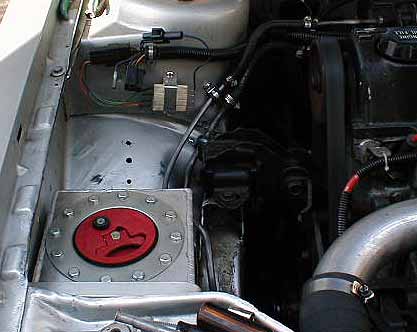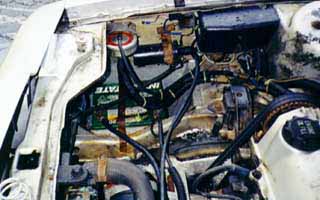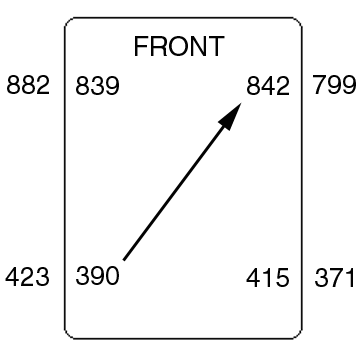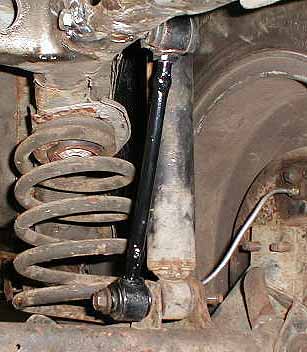
FWD Mopar traction
People ask me what's your secret to make these car so fast? Traction. (Well horsepower never hurt either right?) If you don't hook you will never get the low E.T. Some of this stuff is pure basics that apply to any car- RWD or FWD. On a FWD Mopar 1 tenth you cut off your short time (0-60 ft at the dragstrip) equals 2-3 tenths on the top end.
So lets say your stuck in the mid 14's and your car pulling 2.4 short times- Just reduce your short time to 1.9's or 2.0's and you have a mid to low 13 second car!
The Basic's
1) Lose weight!
Heavy objects are harder to start moving then light objects. (Heavy objects also break things) The lighter you make your car the harder it will hook, the faster it will accelerate and the fewer parts it will break and the less horsepower you will need to run faster! 100 pounds = 1 tenth = 10 hp. So you can make 10 hp or lose 100 pounds off the car, both will have the same effect on your timeslip. Go through the car and lose things- pull off the extra horn, loose the power seat track for a manual one, get manual windows instead of electric's.
Another example- You can have a 3000 lb car making 340 hp running 12.00 or a 2500 lb car making 285 to do the same thing.
2) Lose weight in the right areas!
Weight in the rear of a FWD car is useless- You biggest gains in speed are going to be in removing weight as far back as you can go. Start at the rear bumper and work your way forward. Rolling mass is also a good place to start- Heavy rims act like massive flywheels the car has to spin up to speed to get moving. From the SDML mailing lists-
"I'm surprised I actually read something interesting in this magazine, but has anyone picked up the June issue of Sport Compact Car? There's an editorial called "technobabble" that explains the theory behind rotating weight. We've all heard that "one pound of rotating weight (on the wheels) equals more than three pounds of weight of the car" because that weight is rotating weight, right?"
Chrysler engineer Dave Zelkowski-
It's really related to the moment of inertia. Inertia is not based on the mass as much as geometry. Think of an ice skater spinning during a performance. I'm sure you've noticed that they can spin faster by tucking their arms and legs in. Their mass is exactly the same but by pulling in their limbs they have reduced their moment of inertia. In angular acceleration "torque = moment of inertia X angular acceleration" Therefore " angular acceleration = torque/moment of inertia" Therefore the lower the moment of inertia, the higher the acceleration will be. I really need the Greek alphabet to do this correctly!
I went to lightweight rear tires and rims on the k-car- Not only did it save 36 pounds on the REAR of the car, now I have less rolling resistance AND the 36 pounds is equal to 108 pounds off the body.
Another tire trick to to raise air pressure in the rear tires to lower rolling resistance, on street tires I go 45-50 pounds.
3) If you can't lose weight move it!

Everyone needs fuel to get down the track right? Can't get rid of your fuel supply but you CAN move it to a location where it will do more good! In this picture you can see the front mounted fuel cell over the right front tire. Weight in the back of the car may be evil but weight in front is a godsend to traction. (That's why I never went to lightweight headlights.) The 8 gallon fuel cell I was using was 63 pounds in the back of the car with 7.5 gallons of fuel in it, so now I have saved 43 pounds from the car AND taken the remaining weight and placed it over the "light" front corner of the car.

Here is an early picture of the car- I moved the battery over to the passenger side for better weight balance before I put the fuel cell there (fuel cell was heavier then new battery)
4) Maximize traction by balancing front end.
This is related to the last subject- Moving weight around. In this case you want to get equal amounts of weight over the front tires by moving weight around AND by playing with the suspension.

Let me explain this diagram- What your looking at is how much weight is on each tire of the k-car before it's last radical weight loss plan (2475-2486 with driver, 2250 now) The OUTER numbers were how much WAS on each tire, the inner numbers how much NOW IS. (I had a buddy who is into building circle track racecars come over with his digital scales) How did I get the front tires to get within 3 pounds of each other?
A single air-shock on the left rear of the car set to 90 psi. It cross loads the car throwing weight to the right front AND helps keep the rear end from "squatting" on the launch.

I have also tried making a set of semi-solid rear "struts" for the back of the Reliant to make it super stiff... On a glass smooth track it seems to work fine but on a bumpy track... I don't recommend it. Best runs to date were without them just using the air shock.
Gus has a great page on traction tricks as well.
A note on limited slip or posi diffs- If you have a properly balanced front end generally you don't need a limited slip, however if your car isn't balanced or likes to do one legged burnouts you may have to get one to keep the spider gears from self destructing.
5) Alignment for max bite.
1) Go to a willing front end
alignment shop.
2) Car on rack at weight race with driver in drivers seat.
3) Have rack tech lift front bumper of car about 3-4 inches.
4) Have front end set with front tires dead straight up and down and with zero
toe.
You car lifts the nose a little on launch- Doing the alignment this way simulates a launch so that the tires are as square to the track as possible.
6) Gearing down or staged boost control.
Blowing the tires away on the launch? Assuming you have the suspension setup correct and for the sake of argument your running slicks with the perfect air pressure, gear the car down OR setup a 2 stage boost controller to limit boost on the launch. If your spinning them your loosing ET.
I prefer to gear down myself, the K-car is running 2.76 gears and cuts 1.6 short times!
Tires & slicks
Up to now I have talked about things that can be applied to any car regardless of slicks or DOT legal rubber, time to shift gears ;-)
Street tires- To many out there with to many different compounds. Some like low pressure, others high, some launch better with a burnout, others just turn to slippery plastic like goo if you even think of warming them up. Best thing to do is go to a track and try different things out.
DOT legal "slicks"- Most people report for the money they wear out like crazy and are not much better then street tires when the pedal hits the metal. I'd pass for slicks for the same price.
Slicks- Mickey Thompsons or M&H's
I think M&H's are da bomb! Other people like the M/T's better. M&H's seem to hook better, the M/T's last longer. I'm being general of course but all the faster cars ARE running M&H's including the imports. M&H's like to be run at lower pressures then M/T's as well.
Dan Carson on M/T's
"Just wanted to relate what the Mickey Thompson tech folks told me (it works) This is for the ET Drag series: first burnout of the day, fairly hard, get some smoke, stop when it starts "boiling off". good temp is about 160. The first burnout brings the compound "up". After that, just haze or clean off the tires. Best temp is within 5 degrees of track temp. boy was that a shock. As far as pressure goes, 8-15. For me, 8 psi is way to low. I don't need front end wiggle. Last time I had the pressure at 13 on drivers side, 12 passenger side. This setup seems to work. I only had one run this year (cracked a head), but the 60 ft was a 1.72. There were other factors in this besides the tires: new roll cage (stiffer body), full hard on rear shocks, preload with rear coil-overs, and a "Gus-tified" wood block under the driver side sway bar. Even though there were other factors, I do think the tire advice from MT helped. I used to burn em up and couldn't buy a 1.90. Hope this helps. Take care, Dan"
Gary Donovan on M&H's
Get'em hot. Smoke the crap out of'em. All my best runs have been with huge burnouts with immediate staging. Tire pressures are critical, as little as 3 psi can make a 4-5 tenths difference in ET, I check mine several times a day. Optimum pressure will vary depending slick size, weight on front end and rim width. Relentless like 10 psi, Daytona about 12.
Doing a burnout with an automatic? Get into third before releasing the car from the burnout box. Failure to do so may blow up the over-running clutch in the transmission when the slicks hook up and "shock" the driveline.
The Launch with street tires and manual transmission.
The trick with street tires is to SLIGHTLY engage the clutch while having your right heel on the brake to keep the car from rolling , use your toes to bring the rpms up and the trick is to "slip" the clutch for the first couple of feet while balancing off the gas and clutch pedals- its tricky and not that good for clutch life but I did run 13.3 at 108 with my old Daytona using this method.
The Launch with slicks
Automatics- As little or no tire spin as possible. Simple no?
Manual transmission- My Launches are done by ear- I never look at the tach till the party has started but I can assure you I'm well over the 3500-4000 rpm range when I snap the clutch off. The idea with a manual car is to get the suspension to absorb the first "shock" of the clutch being dropped- If you tighten up the suspension too much it will not hook and you will get wheel hop! Just wind it up and let it rip- the tires will spin just a foot or two (that's the idea) and if you got it just right with a car my weight (3000lbs) 1.89-1.90 short times can be had.
Turbo's don't make real boost till they are under a load- When you launch this way the tires spin a bit to keep engine from bogging AND generates exhaust flow & load to get the turbo up to speed.